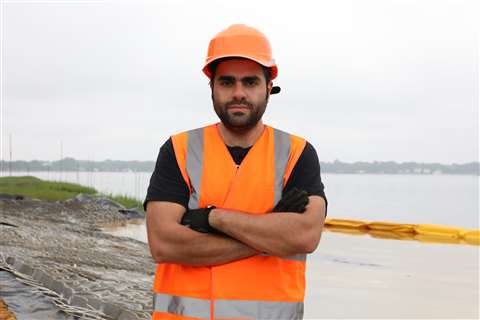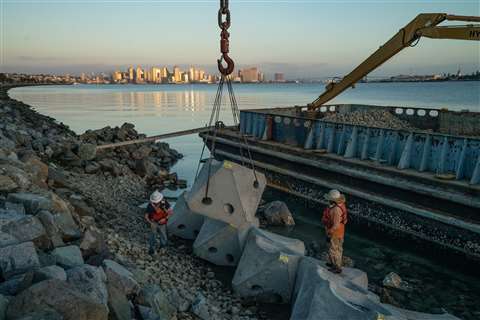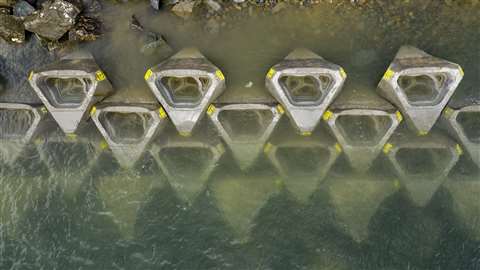A sustainable solution for marine construction
16 May 2022
Where subsea concrete structures are often seen as invaders that damage marine biology, the makers of ECOncrete insist their admix has the potential to bring new life to areas around ports, breakwaters and waterfront developments.
 ECOncrete’s Andrew Rella, PHD. Photo: ECOncrete
ECOncrete’s Andrew Rella, PHD. Photo: ECOncrete
In a Q&A with Construction Europe, the company’s Andrew Rella, PHD, describes the product and the process.
------------------------
Q: How does ECOncrete reduce the amount of cement required? Also, how is it produced without the need for the chemicals present in most concretes used in ports?
A: Our admixture, made from over 50% recycled and by-product materials, can be incorporated directly into the concrete mix in quantity equivalent to 10% of the cementitious materials content. Depending on the mix design, the addition of the admix will increase compressive strength by up to 10%, which in different projects has resulted in an opportunity to reduce the cementitious materials’ original content. The admix is added in addition to the other admix required (such as superplasticisers, air entrainers, retarders, accelerators) to neutralise a number of negative factors of standard concrete and to make the concrete more hospitable to marine life.
ECOncrete technology promotes the recruitment of Calcitic species like barnacles, corals, oysters and coralline algae that encrust the concrete and create a defensive layer of bio-protection. Bio-protection can buffer hydrodynamic and chemical forces and further increase the longevity of the concrete.
Compared with traditional concrete, ECOncrete’s technology has shown the ability to double the biodiversity and abundance of marine species, provide an active carbon sink over the lifespan of the structure, and significantly improve water quality.
 ECOncrete promises structural support, plus native habitat for marine life. Photo: ECOncrete
ECOncrete promises structural support, plus native habitat for marine life. Photo: ECOncrete
Q: Can you tell me a little about the production process? For example, is it difficult to scale up production to meet demand?
A: Our bio-enhancing technologies have been developed so that they can be easily implemented into standard manufacturing methods in a cost-effective and scalable manner.
We do this by incorporating our applicable technology into the standard concrete manufacturing process. Our admixture and unique bio enhancing mould modifying agents, liners, and moulds can be incorporated into any specific project need and location, whether it be wet cast or dry cast precast elements, cast on-site, shotcrete, underwater casting or 3D printing.
Throughout the design process, we work closely with industry leaders -- ranging from concrete machinery providers to concrete and cement giants and world-leading marine engineering firms -- to bring next-generation concrete solutions that will allow responsible coastal and marine construction addressing both structural and environmental performance.
Q: Business seems to be good, but is it difficult to, for example, convince port developers that it’s important to consider the coastal marine life and ecology, or are they sympathetic?
A: When we speak with port developers, they understand quickly that our products and designs have benefits in addition to strong environmental credentials – such as advantages in the permitting process, mitigation costs, as well as the scientifically proven structural benefits and lower maintenance costs.
For instance, in addition to being a more ecologically and environmentally positive alternative, our new armour unit, the Coastalock, retains the needed strength and durability to effectively attenuate wave energy and limit coastal erosion as any standard concrete armour units available in the market.
 ECOncrete says its technology has been shown to reduce the carbon footprint of concrete by up to 70%. Photo: ECOncrete
ECOncrete says its technology has been shown to reduce the carbon footprint of concrete by up to 70%. Photo: ECOncrete
Port developers appreciate solutions with ecological benefits that do not compromise structural or operational performance. We have seen this on several of our projects, including the Port of Vigo, Rotterdam, Hamburg, San Francisco, and San Diego.
Q: How does the material compare with standard concrete, in terms of initial price, lifetime cost, etc? And how does it compare, in terms of its properties?
A: This technology offers a unique return on investment as it is the only concrete technology that complies with international industry standards (ie EN, BS, ASTM and AS standards) and provides biological, environmental, and financial benefits.
Thanks to the technology we provide, projects benefit from reduced environmental mitigation, expedited permitting processes, increased strength and durability, and reduced maintenance.
In one of our projects in the USA, incorporating ECOncrete’s technologies into breakwaters reduced mitigation penalties by approximately 80%, or about US$14 million [c€13.2 million]. That saving equalled approximately 15% of the overall project costs.
In terms of the properties, as mentioned, Coastalock is a good example of the benefits our products offer in comparison to standard concrete. Our patented surface textures also enable our products to act as a firm growth point for marine species, thus encouraging natural habitat creation. This contrasts significantly with standard concrete, which is not conducive to the growth of many marine organisms.
Q: Obviously, there is an environmental benefit for marine life, but what about from a carbon emissions perspective?
A: ECOncrete is a complementary technology and has been implemented in concrete mixes with up to 70% lower carbon footprint compared with standard concrete.
We also offer carbon reduction, given that our admixture is made of over 50% recycled and byproduct materials.
In addition, and most importantly, is the ability of ECOncrete technology to harness the infrastructure during its operational lifetime (usually 60 to 120 years) to offsetting CO2 on a yearly basis. Our bio-enhancing admixture promotes biocalcification and photosynthesis, which is an active carbon sink. For example, 1km of concrete seawall modified by our technology can offset up to 2 tonnes of CO₂ every year; the equivalent of the CO2 offsetting of 100 fully grown trees every year.
Q: Is ECOncrete ever used for land-based structures? Could it be? What about structures such as offshore wind turbines? Or even manmade islands? Do you have wider plans for the material?
A: To date, we have worked hard to develop solutions compatible with coastal construction and marine life, they would not be suitable for land-based structures at this stage.
In 2021, we developed technology and solutions for use in offshore projects, having identified an inherent problem in the future sustainability of offshore infrastructure. Offshore turbines require scour protection and sometimes massive concrete foundations to anchor them in. This can lead to local ecosystem destruction and the proliferation of invasive and nuisance species. However, by incorporating our bio-enhancing concrete solutions, the offshore wind industry can significantly reduce its overall environmental impact and even provide ecosystem services that were never associated with concrete infrastructure in the past.
A good example of this is our recent partnership with Holcim US. We joined forces, with the support of the Department of Energy and the BIRD Foundation, to design and produce an ecologically beneficial concrete scour protection unit for offshore wind turbine foundations. That is a great project, and as we continue to design, develop, and innovate, we look forward to doing more like it.
About Andrew RellaAnswers by Andrew Rella, PhD, ECOncrete’s coastal & environmental engineer and technical director of business development About ECOncreteECOncrete utilises biomimicry and ecological engineering to design concrete infrastructure, with a view to regenerating native marine life, reducing ecological footprints and making concrete structures stronger. |
STAY CONNECTED



Receive the information you need when you need it through our world-leading magazines, newsletters and daily briefings.
CONNECT WITH THE TEAM








